by Randy Anderson
NASCAR Comes to Stateline Speedway
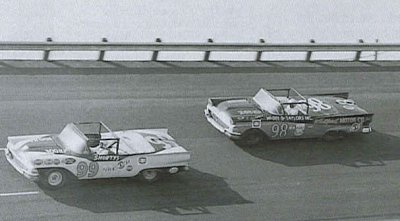
Long before NASCAR races were contested in front of hundreds of thousands of fans, at huge, asphalt racing complexes such as Daytona, Talledaga, Charlotte and Texas, with prize money in the millions of dollars, NASCAR races were often held at small, dirt bullrings, in front of a few thousand fans, with purses paying just several hundred dollars to win. One such NASCAR race was held at Stateline Speedway, near Jamestown, on July 16, 1958.
Len Briggs, Lloyd Williams, Jerry Frank, and Don Frank, the four owners of Stateline Speedway, booked a NASCAR sanctioned race for their one-third mile raceway, fully expecting all the stars of Bill France's Grand National circuit. Among the throttle stompers advertised to appear to compete for the $4,200 total purse were 1956 and 1957 Grand National Division champion Buck Baker, '56 GN runner-up Speedy Thompson, California lead-foot Eddie Pagan, five-time NASCAR Short Track champion, Jim Reed, 1956 and 1957 NASCAR Convertible Division champion Bob Welborn, and the winner of the 1957 beach and road course race at Daytona Beach, Cotton Owens.
Unfortunately for the estimated crowd of 3,500, who paid $3.00 general admission, none of these six drivers showed. According to an account of the race that appeared in the Jamestown Post-Journal "Hard luck continued to dog the Stateline operators, who felt they had a complete NASCAR show signed, sealed, and delivered. Several top drivers, however, failed to show. A rain-shortened program at Raleigh, NC, which broke open an argument over pay, is said to have delayed most of the NASCAR stars who remained in the southern city to continue their efforts to collect."
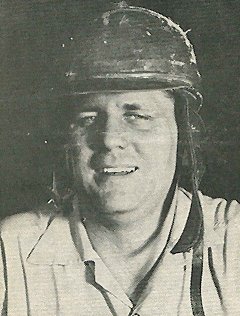
One driver who did find his way to the Busti speed plant was NASCAR pioneer Lee Petty, from Randleman, NC. Petty was considered one of the premier drivers in the GN circuit, having won the championship in 1954 and finishing in the top four point positions every year since the inaugural 1949 season.
Although the vast majority of the twenty-three entrants were "regular" Saturday night racers, "out-of-towners" fared well in the time trials that qualified the drivers for their starting spots in the 150 lap main event. Lee Petty made his presence immediately known as he was fast qualifier in his #42 Oldsmobile, thus earning the inside pole position. Earning the other front row starting position was L.D. Austin of Greenville, SC. Making up the second row of the feature was rookie Lloyd "Shorty" Rollins from Corpus Christi, TX, and Al White from Buffalo. Bob Duell from Warren, PA, wheeling the '57 Ford of Findlay Lake, NY car dealer, Julian Buesink, qualified fifth, while Bill Poor from Wheaton, IL completed the third row.
Lee Petty took the green flag to start the race and led the first thirty laps. Local favorite, Squirt Johns of Brockway, PA passed Petty and set the pace until he blew a tire on his #511 machine on lap 72. Petty regained the point and looked to be on his way to victory until he lost a wheel on the 138th circuit. With Petty's misfortune, Shorty Rollins assumed first place in his number 99 and led the remaining 12 laps to record his first-ever victory in NASCAR's big league division. Rollins earned a large trophy and $600 for his effort. Finishing second, and the only other car to complete the 150 lap distance was Bob Duell, who received $470. The time of the race was 1:03:37. Rollins averaged just over 47 miles per hour.
Of the twenty-three starters, just thirteen were still running when Rollins took the checkered flag. Finishing third was Kenny Johnson (Jamestown), fourth was Emory Mahan (Warren), and fifth was John Seeley (Jamestown). L.D. Austin finished sixth and Bill Poor was seventh. Lee Petty changed his tire and recovered to finish eighth. Bud Fanale (Jamestown) was ninth, while John Walker (Sinclairville) completed the top ten. Bob Schnars (Busti), Carl Tyler (Bradford), and Bud Gardner (Clarenden) were also still racing at the end.
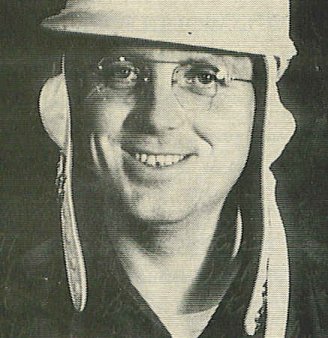
The July 16th race at Stateline was not the first time the NASCAR travelers had visited the NY/PA border area in 1958. Just one month earlier, on June 12th, New Bradford Speedway in Bradford, PA had hosted a 150 lap Grand National race. Legendary NASCAR racer Junior Johnson took the checkers that day earning $550. Lee Petty was second, while pole-sitter Bob Duell finished third. Three local drivers, Dean Layfield, Squirt Johns, and Emory Mahan were all disqualified for "rule infractions" in the post-race inspection process. Allegedly, the three drivers were told their fuel-injected Chevrolets would be allowed to compete in the short field of 21 cars, despite the NASCAR rule permitting only carbureted engines. However, once the race was complete, NASCAR officials buckled under to the protests of the other competitors and sent the three drivers home without pay.
The Post-Journal report about several NASCAR drivers failing to show at the Stateline race because of a pay dispute at a rain-shortened race in Raleigh, does not hold up under scrutiny. A 250 lap race was, in fact, held on the one-mile paved track in Raleigh on July 4th. However, the race was not rain-shortened. Glenn "Fireball" Roberts completed the entire distance, finishing a full lap ahead of runner-up Buck Baker. There is no record that the full purse was not paid.
Two days after the Stateline race, on July 18th, 1958, a Grand National race was held at the on-third mile paved track at the Canadian National Exposition in Toronto. Lee Petty won the 100 lap event over Cotton Owens and Jim Reed, two of the drivers who had failed to show in Busti. However, the race is most notable for NASCAR historians because it was the GN debut of Lee Petty's 21 year old son, Richard. The race recap for that event listed "Dick" Petty, driving car number 142, in 17th place, completing just 55 laps. He was quoted as saying, " It wasn't much of a race for me. I got in Daddy's way when he was lapping me, so he punted me into the fence." Richard, who would eventually become known as the "King", would go on to earn seven NASCAR championships and score 200 victories, the most in NASCAR history. Was Richard with his father at Stateline Speedway, two days before the Toronto race?
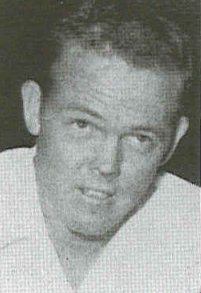
The winner of the Stateline race, Shorty Rollins, went on the win the 1958 NASCAR Rookie of the Year title. The following season, Richard Petty earned the outstanding rookie award. Rollins was from the same hometown, Corpus Christi, TX , as future NASCAR champions, brothers Terry (1984 and 1996) and Bobby (2000) Labonte.
The win at Stateline was the only career Grand National win by Shorty Rollins, but it wasn't his only NASCAR win. In 1959, Bill France opened his mammoth, two and a half mile, high-banked superspeedway at Daytona. The very first competitive event ever contested at the new facility was a Convertible Division race on February 20, 1959, two days prior to the inaugural Daytona 500. Rollins, who had originally registered for the Daytona 500 in the Grand National Division in his "zipper-top" 1958 Ford, noticed the lack of cars entered in the Convertible Division race. So he removed the roof from his Skyliner and reregistered as a Convertible. His decision was a success as he beat Marvin Panch and Richard Petty to the finish line to become the answer to one of auto racing's best trivia questions: "Who won the first race at the Daytona International Speedway"?
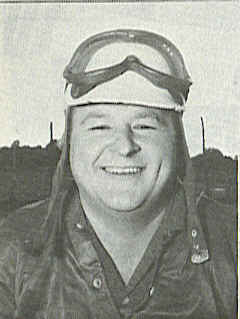
Rollins, Panch, Richard Petty, and the other Convertibles were also permitted to race in the inaugural Daytona 500, but the ragtops proved to be uncompetitive against their hardtop cousins. Lee Petty's '59 Oldsmobile won the Daytona 500 in a photo finish over Johnny Beauchamp's '59 Thunderbird.
The July 16th race at Stateline was event number thirty on the fifty-one race NASCAR GN schedule of 1958. Lee Petty competed in fifty of the events to earn the GN Championship. He would repeat as champion the following year. Petty won seven races, had forty-four top ten finishes, and earned $26,600 in race winnings in 1958. Buck Baker, who had three wins in forty-four starts, finished second in the '58 point chase. Speedy Thompson, four wins in thirty-six starts, was third. Shorty Rollins, with his only win coming at Stateline in twenty-nine starts, was fourth in the championship standings. The leading money winner of 1958 was Fireball Roberts, who won six of the ten big-paying races he entered, earning $32,200.
The additional financial assistance of the community is critical to the success of the Chautauqua Sports Hall of Fame.
We gratefully acknowledge these individuals and organizations for their generous support.













